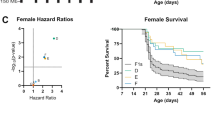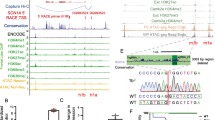Abstract
Previous quantitative trait loci (QTL) mapping studies document that the distal region of mouse Chromosome (Chr) 1 contains a gene(s) that is in large part responsible for the difference in seizure susceptibility between C57BL/6 (B6) (relatively seizure-resistant) and DBA/2 (D2) (relatively seizure-sensitive) mice. We now confirm this seizure-related QTL (Szs1) using reciprocal, interval-specific congenic strains and map it to a 6.6-Mb segment between Pbx1 and D1Mit150. Haplotype conservation between strains within this segment suggests that Szs1 may be localized more precisely to a 4.1-Mb critical interval between Fcgr3 and D1Mit150. We compared the coding region sequences of candidate genes between B6 and D2 mice using RT-PCR, amplification from genomic DNA, and database searching and discovered 12 brain-expressed genes with SNPs that predict a protein amino acid variation. Of these, the most compelling seizure susceptibility candidate is Kcnj10. A survey of the Kcnj10 SNP among other inbred mouse strains revealed a significant effect on seizure sensitivity such that most strains possessing a haplotype containing the B6 variant of Kcnj10 have higher seizure thresholds than those strains possessing the D2 variant. The unique role of inward-rectifying potassium ion channels in membrane physiology coupled with previous strong association between ion channel gene mutations and seizure phenotypes puts even greater focus on Kcnj10 in the present model. In summary, we confirmed a seizure-related QTL of large effect on mouse Chr 1 and mapped it to a finely delimited region. The critical interval contains several candidate genes, one of which, Kcnj10, exhibits a potentially important polymorphism with regard to fundamental aspects of seizure susceptibility.
Similar content being viewed by others
References
J Barclay N Balaguero M Mione SL Ackerman VA Letts et al. (2001) ArticleTitleDucky mouse phenotype of epilepsy and ataxia is associated with mutations in the Cacna2d2 gene and decreased calcium channel current in cerebellar Purkinje cells. J Neurosci 21 6095–6104
JA Beck S Lloyd M Hafezparast M Lennon-Pierce JT Eppig et al. (2000) ArticleTitleGenealogies of mouse inbred strains. Nat Genet 24 23–25
JK Belknap R Hitzemann JC Crabbe TJ Phillips KJ Buck et al. (2001) ArticleTitleQTL analysis and genome wide mutagenesis in mice: complementary genetic approaches to the dissection of complex traits. Behav Genet 31 5–15
KJ Buck P Metten JK Belknap JC Crabbe (1997) ArticleTitleQuantitative trait loci involved in genetic predisposition to acute alcohol withdrawal in mice. J Neurosci 17 3946–3955
KJ Buck P Metten JK Belknap JC Crabbe (1999) ArticleTitleQuantitative trait loci affecting risk for pentobarbital withdrawal map near alcohol withdrawal loci on mouse Chrs 1, 4 and 11. Mamm Genome 10 431–437
Buono RJ, Lohoff FW, Sander T, Sperling MR, O’Connor MJ, Dlugos DJ, Ryan SG, Golden GT, Zhao H, Scattergood TM, Berrettini WH, Ferraro TN (in Press) Association between variation in the human KCNJ10 potassium ion channel gene and seizure susceptibility. Epilepsy Research
DL Burgess JM Jones MH Meisler JL Noebels (1997) ArticleTitleMutation of the Ca2+ channel b subunit gene Cchb4 is associated with ataxia and seizures in the lethargic (Ih) mouse. Cell 88 385–392
C Charlier NA Singh SG Ryan TB Lewis BE Reus et al. (1998) ArticleTitlePore mutation in a novel KQT-like potassium channel gene in an idiopathic epilepsy family. Nat Genet 18 53–55
B Chioza A Osei-Lah H Wilkie L Nashef D McCormick et al. (2002) ArticleTitleSuggestive evidence for association of two potassium channel genes with different idiopathic generalised epilepsy syndromes. Epilepsy Res 52 107–116
GA Cox CM Lutz CL Yang D Biemesderfer RT Bronson et al. (1997) ArticleTitleSodium/hydrogen exchanger gene defect in slow-wave epilepsy mutant mice. Cell 3 139–148
F Engstrom DM Woodbury (1988) ArticleTitleSeizure susceptibility in DBA and C57 mice: the effects of various convulsants. Epilepsia 29 389–395
TN Ferraro RJ Buono (1999) The genetics of epilepsy: mouse and human studies. DW Pfaff (Eds) Handbook of Genetic Influences on the Nervous System CRC Press Boca Raton, FL 117–145
TN Ferraro GT Golden GG Smith NJ Schork P St.Jean et al. (1997) ArticleTitleMapping murine loci for seizure response to kainic acid. Mamm Genome 7 200–208
TN Ferraro GT Golden R Snyder M Laibinis GG Smith RJ Buono WH Berrettini (1998a) ArticleTitleGenetic influences on electrical seizure threshold. Brain Res 813 207–210
TN Ferraro JF Schill C Ballas N Mulholland GT Golden et al. (1998b) ArticleTitleGenotyping microsatellite polymorphisms by agarose gel electrophoresis with ethidium bromide staining: application to quantitative trait loci analysis of seizure susceptibility in mice. Psychiatric Genet 8 227–233
TN Ferraro GT Golden GG Smith Jean St. Schork P et al. (1999) ArticleTitleMapping loci for pentylenetetrazol- induced seizure susceptibility in mice. J Neurosci 19 6733–6739
TN Ferraro GT Golden GG Smith RL Longman RL Snyder et al. (2001) ArticleTitleQuantitative genetic study of maximal electroshock seizure threshold in mice: evidence for a major seizure susceptibility locus on distal Chr 1. Genomics 75 35–42
TN Ferraro GT Golden GG Smith D DeMuth RJ Buono et al. (2002) ArticleTitleMouse strain variation in maximal electroshock seizure threshold. Brain Res 936 82–86
L Flaherty (1981) Congenic strains. HL Foster JD Small JG Fox (Eds) The Mouse in Biomedical Research, Vol. 1. Academic Press New York 215–222
CF Fletcher CM Lutz TN O’Sullivan JD Shaughnessy R Hawkes et al. (1996) ArticleTitleAbsence epilepsy in tottering mutant mice is associated with calcium channel defects. Cell 87 607–617
WN Frankel L Taylor B Beyer BL Tempel HS White (2001) ArticleTitleElectroconvulsive thresholds of inbred mouse strains. Genomics 74 306–312
CS Hall (1947) ArticleTitleGenetic differences in fatal audiogenic seizures between two inbred strains of house mice. J Hered 38 2–6
C Hernandez-Sanchez AS Basile I Fedorova H Arima B Stannard et al. (2001) ArticleTitleMice transgenically overexpressing sulfonylurea receptor in forebrain resist seizure induction and excitotoxin neuron death. Proc Natl Acad Sci USA 98 3549–3554
K Ikeda T Onaka M Yamakado J Nakai TO Ishikawa et al. (2003) ArticleTitleDegeneration of the amygdala/piriform cortex and enhanced fear/anxiety behaviors in sodium pump alpha2 subunit (Atp1a2)-deficient mice. J Neurosci 23 4667–4676
C Karschin A Karschin (1997) ArticleTitleOntogeny of gene expression of Kir channel subunits in the rat. Mol Cell Neurosci 10 131–148
P Kofuji P Ceelen KR Zahs LW Surbeck HA Lester et al. (2000) ArticleTitleGenetic inactivation of an inwardly rectifying potassium channel (Kir4.1 subunit) in mice: Phenotypic impact in retina. J Neurosci . 5733–5740
R Kohling (2002) ArticleTitleVoltage-gated sodium channels in epilepsy. Epilepsia 43 1278–1295
DK Lahiri JI Nurnberger (1991) ArticleTitleA rapid non-enzymatic method for the preparation of high molecular weight DNA from blood for RFLP studies. Nucleic Acids Res 19 5444
ME Legare WN Frankel (2000) ArticleTitleMultiple seizure susceptibility genes on Chr 7 in SWXL-4 congenic mouse strains. Genomics . 7062–7065
ME Legare 2nd Bartlett Frankel FS (2000) ArticleTitleA major effect QTL determined by multiple genes in epileptic EL mice. Genome Research 10 42–48
VA Letts R Felix GH Biddlecome J Arikkath CL Mahaffey et al. (1998) ArticleTitleThe mouse stargazer gene encodes a neuronal Ca2+-channel subunit. Nat Genet 19 340–346
DC Marcus T Wu P Wangemann P Kofuji (2002) ArticleTitleKCNJ10 (Kir4.1) potassium channel knockout abolishes endocochlear potential. Am J Physiol Cell Physiol 282 C403–C407
AE Moseley SP Lieske RK Wetzel PF James S He et al. (2003) ArticleTitleThe Na,K-ATPase alpha 2 isoform is expressed in neurons, and its absence disrupts neuronal activity in newborn mice. J Biol Chem 278 5317–5324 Occurrence Handle10.1074/jbc.M211315200 Occurrence Handle1:CAS:528:DC%2BD3sXhtVKlur0%3D Occurrence Handle12458206
JH Nadeau WN Frankel (2000) ArticleTitleThe roads from phenotypic variation to gene discovery: mutagenesis versus QTLs. Nat Genet 25 381–384 Occurrence Handle10.1038/78051 Occurrence Handle1:CAS:528:DC%2BD3cXlvVertb8%3D Occurrence Handle10932178
C Neusch N Rozengurt RE Jacobs HA Lester P Kofuji (2001) ArticleTitleKir4.1 potassium channel subunit is crucial for oligodendrocyte development and in vivo myelination. J Neurosci 21 5429–5438 Occurrence Handle1:CAS:528:DC%2BD3MXlsV2gsb4%3D Occurrence Handle11466414
N Patil DR Cox D Bhat M Faham RM Myers (1995) ArticleTitleA potassium channel mutation in weaver mice implicates membrane excitability in granule cell differentiation. Nat Genet 11 126–129 Occurrence Handle1:CAS:528:DyaK2MXosF2rsbY%3D Occurrence Handle7550338
J Fritsch EF Sambrook T Maniatis (1989) Molecular Cloning: A Laboratory Manual, 2nd ed. Cold Spring Harbor Laboratory Press Cold Spring Harbor, N.Y.
K Schlesinger WO Boggan BJ Griek (1968) ArticleTitlePharmacogenetic correlates of pentylenetetrazol and electroconvulsive seizure thresholds in mice. Psychopharmacology (Berl) 13 181–188 Occurrence Handle1:CAS:528:DyaF1cXltVCqurs%3D
S Signorini YJ Liao SA Duncan LY Jan M Stoffel (1997) ArticleTitleNormal cerebellar development but susceptibility to seizures in mice lacking G protein-coupled, inwardly rectifying K channel GIRK2. Proc Natl Acad Sci USA 94 923–927 Occurrence Handle10.1073/pnas.94.3.923 Occurrence Handle1:CAS:528:DyaK2sXhtVOrtro%3D Occurrence Handle9023358
NA Singh C Charlier D Stauffer BR DuPont RJ Leach et al. (1998) ArticleTitleA novel potassium channel gene, KCNQ2, is mutated in an inherited epilepsy of newborns. Nat Genet 18 25–29 Occurrence Handle1:CAS:528:DyaK1cXivFWnsw%3D%3D Occurrence Handle9425895
OK Steinlein JC Mulley P Propping RH Wallace HA Phillips et al. (1995) ArticleTitleA missense mutation in the neuronal nicotinic acetylcholine receptor alpha 4 subunit is associated with autosomal dominant nocturnal frontal lobe epilepsy. Nat Genet 11 201–203 Occurrence Handle1:CAS:528:DyaK2MXosF2rt74%3D Occurrence Handle7550350
T Takumi T Ishii Y Horio K Morishige N Takahashi et al. (1995) ArticleTitleA novel ATP-dependent inward rectifier potassium channel expressed predominantly in glial cells. J Biol Chem 270 16339–16346 Occurrence Handle10.1074/jbc.270.2.765 Occurrence Handle1:CAS:528:DyaK2MXmvVGnt7k%3D Occurrence Handle7608203
BA Taylor (1976) ArticleTitleGenetic analysis of susceptibility to isoniazid-induced seizures in mice. Genetics 83 373–377
BA Taylor WN Frankel (1993) ArticleTitleA new strain congenic for the Mtv-7/Mls-1 locus of mouse chromosome 1. Immunogenetics 38 235–237
CM Wade 3rd Kulbokas Kirby EJ Zody AW Mullikin MC et al. (2002) ArticleTitleThe mosaic structure of variation in the laboratory mouse genome. Nature 420 574–578 Occurrence Handle10.1038/nature01252 Occurrence Handle1:CAS:528:DC%2BD38Xpt1WhsL4%3D Occurrence Handle12466852
RH Wallace DW Wang R Singh IE Scheffer AL George et al. (1998) ArticleTitleFebrile seizures and generalized epilepsy associated with a mutation in the Na+-channel beta 1 subunit gene SCN1B. Nat Genet 19 366–370 Occurrence Handle10.1038/448 Occurrence Handle1:CAS:528:DyaK1cXlt1Cisr0%3D Occurrence Handle9697698
AD Wickenden (2002) ArticleTitlePotassium channels as anti-epileptic drug targets. Neuropharmacology 43 1055–1060 Occurrence Handle10.1016/S0028-3908(02)00237-X Occurrence Handle1:CAS:528:DC%2BD38Xps12mu7o%3D Occurrence Handle12504910
Z Yang H Xu N Cui Z Qu S Chanchevalap et al. (2000) ArticleTitleBiophysical and molecular mechanisms underlying the modulation of heteromeric Kir4.1-Kir5.1 channels by CO2 and pH. J Gen Physiol 116 33–45 Occurrence Handle10.1085/jgp.116.1.33 Occurrence Handle1:CAS:528:DC%2BD3cXls1Klt7c%3D Occurrence Handle10871638
Author information
Authors and Affiliations
Corresponding author
Rights and permissions
About this article
Cite this article
Ferraro, T.N., Golden, G.T., Smith, G.G. et al. Fine mapping of a seizure susceptibility locus on mouse Chromosome 1: nomination of Kcnj10 as a causative gene . Mamm Genome 15, 239–251 (2004). https://doi.org/10.1007/s00335-003-2270-3
Received:
Accepted:
Issue Date:
DOI: https://doi.org/10.1007/s00335-003-2270-3




